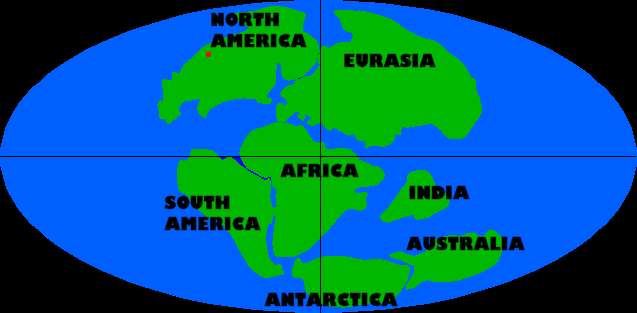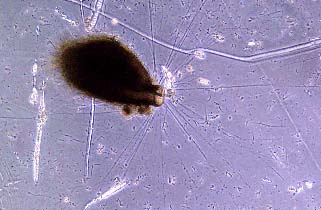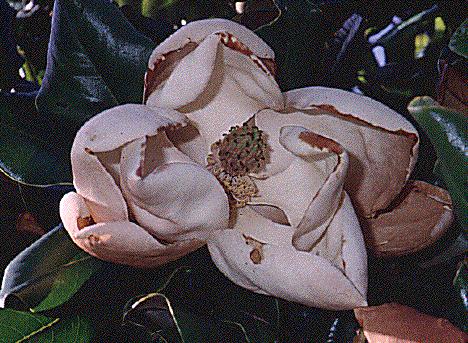Cretaceous Period
The Age of the Dinosaurs
The Cretaceous Period is known as the "Age of Dinosaurs". This due to dinosaurs being the most conspicuous and perhaps most numerous vertebrate during this age.
The name Cretaceous, however, is derived from the Latin word, Creta, meaning chalk. Belgian geologist, D'Omalius d'Halloy, assigned this name in 1822 after finding considerable amounts of chalky strata throughout France, Belgium, Holland, England, Sweden, and Poland. All of which were deposited during this period.
The Cretaceous Period is the latest time period for the Mesozoic era, lasting from 138 mya to about 65 mya.
Time table Here's anotherEvents Marking
the Beginning and End of the Cretaceous
Beginning
No great extinction or burst of diversity separated the Cretaceous from the Jurassic. Perhaps the most important event in terms of terrestrial life was the appearance of flowering plants, known as angiosperms or Anthophyta. They first appeared around 125 mya and radiated around 100 mya.
Ending
One of the most famous extinctions marks the end of the Cretaceous Period, 65 mya. It is named the Cretaceous-Tertiary Extinction (commonly known as the K-T event), and is known by most as the period in which dinosaurs died out. Many other lineages of marine reptiles went extinct as well including ichthyosaurs, pleisiosaurs, and mosasaurs. Flying pterosaurs also went extinct, ammonites, and species of foraminiferans as well. Groups such as the angiosperms, gastropods, amphibians, lizards and snakes, crocodiles, and mammals sailed through this K-T event with few or apparent extinctions at all.
Climate
Climates during the Cretaceous period seem to have remained fairly constant throughout with the temperature being warm and mild. At the stage of the Late Cretaceous, however, there is evidence suggesting a rapid cooling effect. Data supporting these theories arise from the animal, marine, and vegetation fossils found. Vegetation perhaps is the best indicator for it is directly exposed to the atmosphere and through its structure and composition helps reflect climate.
Evidence of Warm
Climate:
Dinosaurs are generally thought to have preferred warm climates
The presence of dinosaurs in the polar regions reflect an even temperature gradient with the climate at the poles not being drastically different from that near the equator
The poles were ice-free with Arctic water temperatures of around 14 degrees C
Warm-water sea animals were widespread, and animals such as coccoliths were known only to live in warm waters
Coral reefs grew 5 to 15 degrees closer to the poles than today
Conifer and deciduous plant fossils found near the poles suggest that winter temperatures were not as low as they are today
At mid latitudes, forests and open canopy woodlands were dominated by a mixture of ferns and conifers, and at low latitudes, which would be near the equator, patchy forests that would have suggested a hot, arid environment were not seen
Evidence of Change:
Planktonic foram fossils, like that of Nephrolithus frequens, shifted away from the poles and more towards the equator
Fossils of cool-water assemblages are found only near the South Pole, suggesting that true cold water during the Late Cretaceous occurred mainly at the South Pole while the rest of the earth’s oceans remained relatively warm
This is very different from today where shallow ocean temperatures vary from 20 degrees C in the tropics to close to zero at the poles
Seasonal temperate conifers that had come to dominate mammalian habitats displaced lush, subtropical habitats
Note* Ironically, there were probably more species of animals during times where there was a gradient in climate. A uniform, warm climate may result in widespread fauna, but they are not necessarily as rich and diverse as the fauna found in climatic zones.

Continental Drift
At the start of the Cretaceous Period separation of the supercontinent Pangaea into Laurasia and Gondwana had already been completed. Therefore, in the Early Cretaceous:
- Gondwanaland began to break apart
- South America and North America were separate throughout the Cretaceous Period, but North America remained connected to Europe via Greenland
- India broke free, became an island continent, and began to move north
- The North Atlantic began to widen
- Widespread volcanism occurred
- Polar land masses such as North Alaska and South Australia were found around the Arctic and Antarctic Circles
- Sea levels were 25m higher than they are today

During the Mid-Cretaceous:
- The Tethys Sea began to close
- The Alps began to form after the African continental plate broke and drifted north subjecting Tethys Sea sediments to powerful compressions
- Volcanic activity at mid-Atlantic ridges created new ocean crust that pushed continental landmasses further apart. The sea floor spreading rates were three times than today
- Sea floors rose and in turn caused sea water levels to rise creating worldwide flooding of up to 40% of the continents
- Outpouring lava also created a great undersea plateau across the southern Pacific Ocean right at the time of the max of the Cretaceous’s warmest climate
During the Late-Cretaceous:
- Sea levels rose dramatically up to 200m above present day levels. This is known as the Cenomanian marine transgression
- This effect produced major inland seas
- It also created extensive continental rifting and many isolated land masses
- At the end, there was a rapid decline of global sea levels reducing the area of shallow marine environments

Ecological
Communities/Adaptive Radiations
Microorganisms


The Cretaceous Period saw a great flourishing of planktonic microorganisms. Planktonic foraminifera heavily radiated to new areas. These were single-celled protests that had shells made of organic materials, such as sand grains and other particles cemented together, or crystalline calcite. The calcareous nannoplankton are believed to have led to a number of chalk deposits due to their shells that would sink to the bottom and accumulate after they had died. This period also witnessed the appearance and adaptative radiation of the diatoms. Although diatoms may have been present during the Jurassic, any reports of diatom fossils found for this period are highly doubted since silica is known to recrystallize under pressure. The richest source of diatom fossils are deposits of their skeletons known as diatomites, or diatomaceous earth. This mineral was formed also after diatoms had died and settled to the bottom of a lake or ocean. Therefore, they form the other large portion of chalk deposits.
Note* Most of these chalky materials are mined for use in cleaners, paints, filtering agents, and abrasives. Many types of toothpaste also contain bits of fossil diatoms.
Plants

Flora from the Jurassic could still be found in the Cretaceous and included gymnosperms such as ferns, palms, cycads, and conifers. The most dramatic occurrence during the Cretaceous was the first appearance of flowering plants, the ANGIOSPERMS!! These also included trees, grasses, and herbs. From the time of their arrival to the end of the Cretaceous, the angiosperms thrived and radiated to become the dominant plant by the early Paleocene. They evolved a number of today’s modern plants.
Question* Were the first angiosperms trees or herbs?
Answer:
Click Here
Marine Invertebrates


Ammonites, belemnites, and other mollusks were abundant throughout the Cretaceous. Sponges, bivalves, and echinoids were present as well. Higher crustaceans such as lobsters soon became common, and corals were essentially of modern types. Modern gastropods, especially Neogastropods, also began to appear. These newer gastropods differed from those previous in that these were largely carnivorous, and like mesogastropods were able to live in sandy environments. Recent research has investigated possible coevolution between predatory gastropods, especially naticids, and their prey of bivalve mollusks. The naticids attacked by drilling through the bivalves’ shell. The attacks became widespread throughout the Cretaceous, and study of drilling behavior showed a remarkable progression over geological time in terms of position over prey and ability to resume attack after interruption. There also was a mutual increase in size. Cretaceous reefs were made largely made up of rudists, which were large bivalves with one cone-shaped valve and the other reduced to a small lid-like structure. A single rudist could be a meter in height, and grew rapidly with the help of symbiotic algae.
Here's a fun viewingFish
The modern teleost fish became widespread during the Mid and Late Cretaceous. Modern sharks also appear during this time.
Terrestrial Invertebrates
The introduction of angiosperms greatly stimulated the evolution of insects. The explosion occurred most dramatically in insects that promoted plant pollination. The oldest known ants and butterflies also appeared and began to diversify during the Cretaceous.
Amphibians
In the Cretaceous Period, they were only represented by existing groups such as frogs and salamanders.
Reptiles
The chelonia, which included turtles and tortoises, were common and included representatives from both living and extinct groups. Some marine forms gained enormous size, such as the Archelon, which grew to 3 meters. Another lineage of aquatic lizards, the predatory Mosasauridae, evolved into gigantic marine forms with lengths up to 10 meters or more. The Sphenodontia were reduced in size due to their ecological role being taken by the Squamata (lizards and snakes). Ichthyosauria were also greatly reduced with only a single family surviving through the Late Cretaceous. It is believed they were unable to adapt to the new fast-swimming telost fish. Therefore, they died out long before the Cretaceous ended. Plesiosaurs, on the other hand, were represented by a number of new forms, including the Polycotylidae, Cimoliosauridae, and the long-necked Elasmosaurids. Eusuchia (modern crocodiles) evolved for the first time, while more primitive groups continued. The sea crocodiles died out early in the Cretaceous, whereas, warm tropic conditions benefited fresh-water crocodiles, which grew to large sizes. These gigantic crocodiles would feed on a dinosaur the same way a modern day crocodile would grab an ungulate mammal (like a zebra) approaching water to drink.
Birds and Mammals
Many new mammal groups appeared during this time, including the placentals, marsupials, and monotremes (did not give live birth, rather laid eggs). All of these appeared sometime during the Mid-Cretaceous. The earliest placentals were diverse, yet they were all similar to shrews and moles in that all were lumped into the order Insectivora. It is from these insectivore-like creatures that all later placental orders sprang. Mammals, along with birds, diversified to exploit the increase in both edible plant parts and insects. Virtually all Cretaceous mammals had sharp cutting ridges on their molar teeth that were well suited for slicing insect tissue. Birds displayed an extraordinary range, often times with many dinosaur proto-like birds. Dinosaurs also took on bird-like forms, such as the bird-like Ornithomimosaurs. Therefore, it would have been nearly impossible during the Cretaceous to tell where dinosaurs ended and birds began. Birds, however, did seem to push the Pterosaurs (flying reptiles) closer to extinction.

Dinosaurs
There were a lot!! Take a look.
Click hereIt was among the theropod carnivores that a large radiation could be found between large and small bird-like forms. These ranged from the giant Charcharodontosaurs, Spinosaurs, and Tyrannosaurs to the medium-sized and sickle-clawed Deinonychids. Both eventually led down to the bird-like Ornithomimosaurs. The Ceratopsia (horned dinosaurs) evolved and stayed mainly in Asiaamerica, while the heavily armored Ankylosauria replaced the plated Stegosauria. Interestingly enough, the unarmored Ornithopod dinosaurs were the most abundant and diverse group of herbivores.
Fossil Resources
The angiosperms are largely represented in the fossil record thru organs like pollen, leaves, and seeds, which were dispersed or shed during life. The smallest and widely dispersed angiosperms are the most likely to be preserved. The earliest recognizable angiosperm fossils are pollen grains named Clavatipollenites that were found in England, West Africa, Argentina, and eastern North America. This pollen was found to be very similar to the grains produced by modern members of the magnoliid dicotyledon family Chloranthaceae. As far as mammals go, Early Cretaceous rocks have produced little mammalian material except for some teeth and jaw fragments.
To see some sites for dinosaur fossils click here
Extinctions
During the End-Cretaceous (K-T) extinction eighty-five percent of all species disappeared. This makes it the second largest mass extinction event in geological history. It is the extinction that gets most of the public’s attention because it led to the demise of the dinosaurs. While the dinosaurs were the most unfortunate victims, many other terrestrial and marine biotic groups severely suffered as well. Those that perished alongside the dinosaurs included pterosaurs, belemnoids, ammonoids, marine reptiles, and rudist bivalves. Those that were severely affected included planktic foraminifera, nannoplankton, diatoms, mollusks, and echinoids. Most mammals, birds, turtles, crocodiles, lizards, and amphibians were unaffected by the K-T event. There are many theories behind possible causes for this extinction. Here are a few:
This will help explain it all
Glossary
Ichtyosaurs:
Marine reptiles specialized for aquatic life that possessed a streamlined body with a long snout, limbs reduced to small fins for steering, and a large lunate caudal fin.Pleisiosaurs: Marine reptiles with dorsoventrally flattened bodies and limbs modified into paddles.
Mosasaurs: A very large marine fish-eating lizard that had modified limbs as paddles and is related to the recent monitor lizard.
Nannoplankton: The smallest plankton that consists of organisms, like bacteria, that could pass through fine mesh silk cloth.
Gastropods: Any large class of mollusks (snails, slugs) that usually have a univalve shell or none and a distinct head bearing sensory organs.
Ammonites: A subclass of extinct cephalopods (marine mollusks that included squid and octopus) with flat spiral shells.
Belemnites: A genus of extinct cephalopods that had bullet-shaped internal shells.
Bivalves: Marine mollusks with two-valved shells, like clams
Teleost: Fishes with bony, rather than cartilaginous, skeletons. Examples include marlins, salmon, and ocean sunfish.
Sphenodontia: Those dinosaurs with wedged teeth.
Theropod: Carnivorous, bipedal dinosaurs that usually had small forelimbs.
Ornithopod: Bipedal ornithischian (the pubis of the pelvis rotated backward to a position parallel and close to the ischium) dinosaurs that possessed digitigrade walking limbs and only three functional toes.
Literature Cited
Bearbower, James R. Search for the Past. Prentice Hall, Inc. Englewood Cliffs, NJ. 1990. Pg. 472-477
Briggs, Derek E. and Crowther, Peter R. Paleobiology. Blackwell Scientififc Publications. Cambridge, MA. 1990. Pg. 80-83 and 137-138
Forty, Richard. Fossils: The Key to the Past. Harvard University Press. Cambridge, MA. 1991. Pg 134-139
Klein, Richard G. The Human Career. University of Chicago Press. Chicago, IL. 1992. Pg. 91-92
Lockley, Martin and Meyer, Christian. Dinosaur Tracks and Other Fossil Footprints of Europe. Columbia University Press. New York, NY. 2000
Macleod, Norman and Keller, Greta. Cretaceous-Tertiary Mass Extinctions: Biotic and Environmental Changes. W.W. Norton & Company. New York, NY. 1996
Links
www.ucmp.berkeley.edu/mesozoic/cretaceous/cretaceous.html
www.enchantedlearning.com/subjects/dinosaurs/mesozoic/Cretaceous.html
dsc.discovery.com/stories/dinos/bbc/chronology/65/index.html